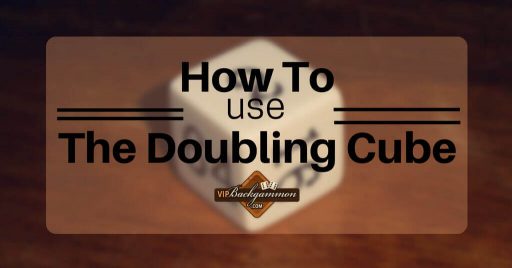Content Table:
Advanced Backgammon Strategies Using the Doubling Cube
Although the Doubling Cube is unknown to most of the casual backgammon players, it is an essential tool in advanced backgammon strategies and in money matches and tournaments.
The Importance of the Doubling Cube
This cube is designated for raising the stakes of the match, and its introduction to the backgammon world is one of the main reasons for the rise in popularity of backgammon.
Understanding the Doubling Cube
The cube has six faces with the numbers written on it: 2, 4, 8, 16, 32, 64.
At the beginning of the match, the doubling cube is placed beside the board or on the Bar between the players.
Any player who feels at any stage of the match that they are leading sufficiently can suggest doubling the stakes by placing the doubling cube with the number 2 facing up before throwing their dice.
For example, if player A decides to raise the stakes:
- Player B, the opponent, can either refuse the offer, thus losing the game and one unit, or agree to double the stakes, continuing the match with higher stakes.
If player B agrees to the offer, they now own the doubling cube, meaning only they have the option to double the stakes again at any stage of the game. If player B decides to do so, they must do it on their turn before throwing their dice, placing the number 4 facing up.
Player A now faces the same two options: if they decline the offer, they will lose two units; if they agree, the stakes rise to four times the original amount, and the doubling cube returns to player A’s control.
The cube can pass from player to player, each time raising the stakes.
The Crawford Rule
If you are playing a game until N points, and your opponent is leading and reaches N-1 points, meaning they are one point from winning the game, you cannot use the Doubling Cube in the following game. However, you can use the dice in subsequent matches if the game continues. This rule exists because the weaker player will always want to raise the stakes, and we want to maintain fairness for both sides.
The Jacoby Rule
This rule is used in money games but not in match games. It states that a backgammon or gammon may not be scored as such unless the cube has been passed and accepted. This rule speeds up the game.
The Holland Rule
The Holland Rule is used in match games and stipulates that in post-Crawford games, the trailing player can only double after both sides have played two rolls. This rule makes the free drop more valuable to the leading player but is not popular and is rarely used today.
Animals in Backgammon
Animals such as beavers, raccoons, and otters appear only if both sides agree, in money games and never in match games. If player A doubles the stakes, and player B believes they have the advantage, B can double the stakes and keep the doubling cube on their side. For example, if A makes the initial double and puts the cube on 2, B can say ‘Beaver,’ turning the cube to 4 and keeping it at their side. If A believes B is wrong, they can say ‘Raccoon’ and turn the cube to 8, remaining the owner of the doubling cube. If B wishes to raise the stakes again, they simply say another animal name and so on.
The Chouette
Chouette is a version of backgammon for more than two players. One player is the ‘Box’ and plays against the rest of the group on a single board. Another player is the ‘Captain’ of the group, who throws the dice and makes moves for the group against the Box.
If the Box wins, the Captain goes to the back of the line, and the next player becomes the new Captain. If the Captain wins, they become the new Box, and the old Box goes to the end of the line.
The rules regarding the ability of the group to consult with the Captain vary by version. In some, the group can freely advise the Captain; in others, consulting is strictly forbidden. The most popular version allows consulting only after the dice have been thrown.
Originally, Chouette was played with a single die. Players other than the Captain could only make decisions regarding takes: if the Box doubled, each player could take or drop independently. Today, a multiple-cube Chouette is more popular; each player has their own cube, and all doubling, dropping, and taking decisions are made independently.
